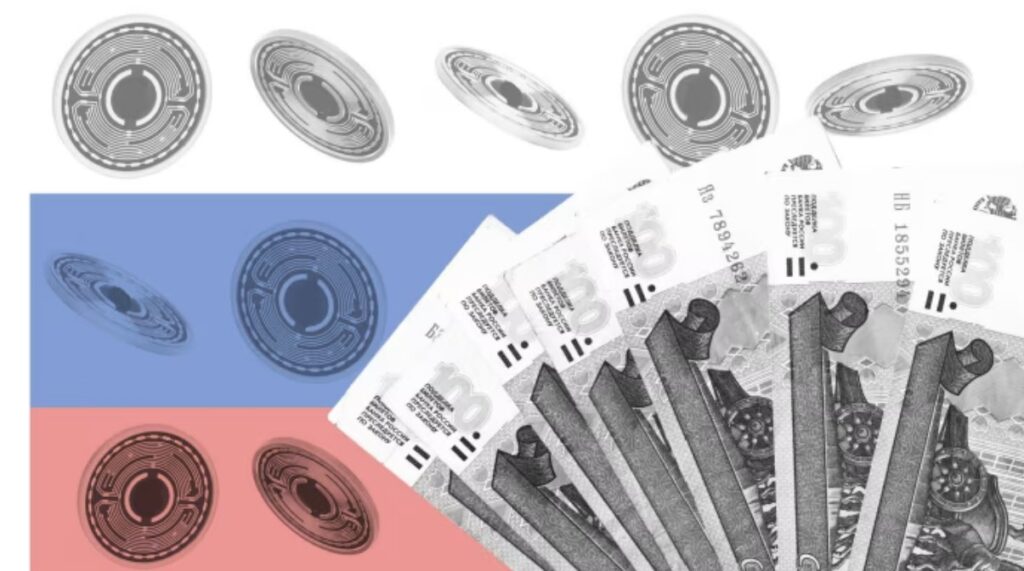BISHKEK / MOSCOW / LONDON (Realist English). A new cryptocurrency token designed to bypass Western sanctions on Russia has quietly moved $9.3 billion in just four months, according to an investigation by the Financial Times. The stablecoin, A7A5, pegged to the Russian rouble, was launched in February 2025 from Kyrgyzstan and is already becoming a cornerstone of a shadow financial system serving sanctioned Russian interests.
Promoted as the first rouble-backed stablecoin, A7A5 is linked to Promsvyazbank, a key financial institution for Russia’s defense sector currently under U.S., UK and EU sanctions. Despite this, A7A5 has quickly circulated 12 billion tokens, now worth an estimated $156 million, with trading concentrated on a Kyrgyz exchange called Grinex — also launched this year.
An FT blockchain analysis found 124 wallets moving large sums via Grinex, often mimicking internal banking transfers. Most transactions occurred during Moscow business hours, further suggesting Russian origin.
Behind the token: sanctions, influence, and Ilan Șor
A7A5 was initially developed by A7, a company majority-owned by Ilan Șor, a Moldovan oligarch convicted in a $1 billion banking fraud and currently under UK sanctions. Șor fled to Russia in 2019, became a Russian citizen, and is accused of financing vote-buying schemes in Moldova — which he denies.
A new report from the Centre for Information Resilience (CIR) links A7 and A7A5 to online infrastructure used in Russian political influence campaigns in Moldova. While A7A5 claims to have formally severed ties with A7 last month, CIR and open-source data suggest deep entanglement.
Garantex legacy and Kyrgyz cover
The rise of A7A5 and Grinex follows the March 2025 U.S. takedown of Garantex, a Russia-based crypto exchange accused of laundering over $60 billion. Tether froze $23 million of Garantex-linked assets, triggering panic in the Russian crypto ecosystem.
Shortly after, large volumes of USDT from Garantex migrated into A7A5. Grinex and A7A5 were registered in Kyrgyzstan the same week, and footage from Garantex’s office showed A7A5 branding. Blockchain forensics suggest Grinex is effectively a successor to Garantex, a claim both platforms deny.
In a statement to FT, Grinex insisted it is independent and compliant with international sanctions. “Coincidence of registration dates and activity spikes does not prove affiliation,” a spokesperson said.
A bridge to USDT and beyond
A7A5 users can convert roubles into tokens, use them to buy Tether (USDT), and then cash out abroad — creating a sanctions-resistant path for Russian capital. According to director Leonid Shumakov, the token offers “a bridge for safe transition” to dollar-linked assets and is primarily used by Russian importers.
While A7A5 claims every token is backed by rouble reserves held at Promsvyazbank, those reserves are not externally verifiable beyond a reported audit in Kyrgyzstan.
A new financial architecture?
At a recent forum, Șor described plans to build a “sufficiently invulnerable payments system” involving crypto, precious metals, and non-Western securities — explicitly aimed at evading sanctions. CIR uncovered job listings from A7 for Chinese speakers, UAE-based accountants, and energy specialists — including in Russian-occupied Ukrainian regions.
U.S. authorities allege Șor was also engaged in discussions with Keremet Bank in Kyrgyzstan to establish a sanctions evasion hub. That bank was sanctioned by the U.S. Treasury in January.
A7A5 and Grinex refused to answer questions about Keremet Bank or Șor’s direct involvement.
The rapid rise of A7A5 signals a new phase in Russia’s response to financial isolation — one that blends blockchain anonymity with state-aligned institutions and foreign proxies. While the token claims transparency and compliance, its structure and timing suggest strategic intent: to carve out an alternative to the dollar-based system under the guise of decentralization. For Western regulators, the lesson is clear — crypto infrastructure, even in far-flung jurisdictions like Kyrgyzstan, may now serve as the new front line in sanctions resistance.
